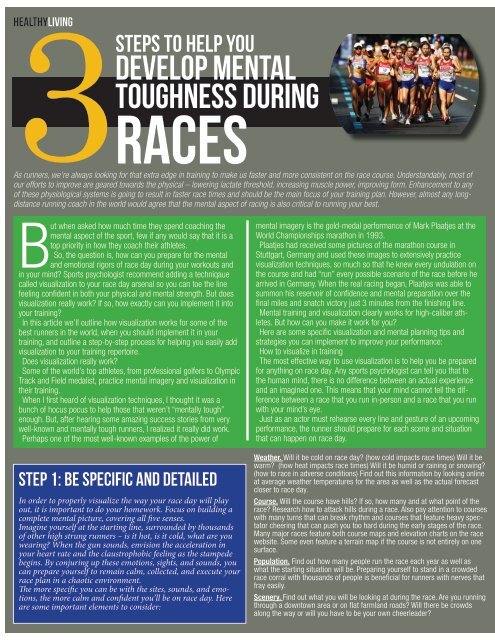Nyrstar Clarksville Health & Wellness Magazine - Issue 10, October 2016
Nyrstar Clarksville Health & Wellness Magazine - Issue 10, October 2016
Nyrstar Clarksville Health & Wellness Magazine - Issue 10, October 2016
You also want an ePaper? Increase the reach of your titles
YUMPU automatically turns print PDFs into web optimized ePapers that Google loves.
14 HEALTH & WELLNESS<br />
HEALTHYLIVING<br />
STEPS TO HELP YOU<br />
DEVELOP MENTAL<br />
Toughness During<br />
RACES 3As runners, we’re always looking for that extra edge in training to make us faster and more consistent on the race course. Understandably, most of<br />
our efforts to improve are geared towards the physical – lowering lactate threshold, increasing muscle power, improving form. Enhancement to any<br />
of these physiological systems is going to result in faster race times and should be the main focus of your training plan. However, almost any longdistance<br />
running coach in the world would agree that the mental aspect of racing is also critical to running your best.<br />
But when asked how much time they spend coaching the<br />
mental aspect of the sport, few if any would say that it is a<br />
top priority in how they coach their athletes.<br />
So, the question is, how can you prepare for the mental<br />
and emotional rigors of race day during your workouts and<br />
in your mind? Sports psychologist recommend adding a techniqaue<br />
called visualization to your race day arsenal so you can toe the line<br />
feeling confident in both your physical and mental strength. But does<br />
visualization really work? If so, how exactly can you implement it into<br />
your training?<br />
In this article we’ll outline how visualization works for some of the<br />
best runners in the world, when you should implement it in your<br />
training, and outline a step-by-step process for helping you easily add<br />
visualization to your training repertoire.<br />
Does visualization really work?<br />
Some of the world’s top athletes, from professional golfers to Olympic<br />
Track and Field medalist, practice mental imagery and visualization in<br />
their training.<br />
When I first heard of visualization techniques, I thought it was a<br />
bunch of hocus pocus to help those that weren’t “mentally tough”<br />
enough. But, after hearing some amazing success stories from very<br />
well-known and mentally tough runners, I realized it really did work.<br />
Perhaps one of the most well-known examples of the power of<br />
mental imagery is the gold-medal performance of Mark Plaatjes at the<br />
World Championships marathon in 1993.<br />
Plaatjes had received some pictures of the marathon course in<br />
Stuttgart, Germany and used these images to extensively practice<br />
visualization techniques, so much so that he knew every undulation on<br />
the course and had “run” every possible scenario of the race before he<br />
arrived in Germany. When the real racing began, Plaatjes was able to<br />
summon his reservoir of confidence and mental preparation over the<br />
final miles and snatch victory just 3 minutes from the finishing line.<br />
Mental training and visualization clearly works for high-caliber athletes.<br />
But how can you make it work for you?<br />
Here are some specific visualization and mental planning tips and<br />
strategies you can implement to improve your performance:<br />
How to visualize in training<br />
The most effective way to use visualization is to help you be prepared<br />
for anything on race day. Any sports psychologist can tell you that to<br />
the human mind, there is no difference between an actual experience<br />
and an imagined one. This means that your mind cannot tell the difference<br />
between a race that you run in-person and a race that you run<br />
with your mind’s eye.<br />
Just as an actor must rehearse every line and gesture of an upcoming<br />
performance, the runner should prepare for each scene and situation<br />
that can happen on race day.<br />
Step 1: Be specific and detailed<br />
Weather. Will it be cold on race day? (how cold impacts race times) Will it be<br />
warm? (how heat impacts race times) Will it be humid or raining or snowing?<br />
(how to race in adverse conditions) Find out this information by looking online<br />
at average weather temperatures for the area as well as the actual forecast<br />
closer to race day.<br />
In order to properly visualize the way your race day will play<br />
out, it is important to do your homework. Focus on building a<br />
complete mental picture, covering all five senses.<br />
Imagine yourself at the starting line, surrounded by thousands<br />
of other high strung runners – is it hot, is it cold, what are you<br />
wearing? When the gun sounds, envision the acceleration in<br />
your heart rate and the claustrophobic feeling as the stampede<br />
begins. By conjuring up these emotions, sights, and sounds, you<br />
can prepare yourself to remain calm, collected, and execute your<br />
race plan in a chaotic environment.<br />
The more specific you can be with the sites, sounds, and emotions,<br />
the more calm and confident you’ll be on race day. Here<br />
are some important elements to consider:<br />
along the way or will you have to be your own cheerleader?<br />
<strong>Nyrstar</strong> <strong>Health</strong> & <strong>Wellness</strong> Newsletter | <strong>October</strong> <strong>2016</strong><br />
Course. Will the course have hills? If so, how many and at what point of the<br />
race? Research how to attack hills during a race. Also pay attention to courses<br />
with many turns that can break rhythm and courses that feature heavy spectator<br />
cheering that can push you too hard during the early stages of the race.<br />
Many major races feature both course maps and elevation charts on the race<br />
website. Some even feature a terrain map if the course is not entirely on one<br />
surface.<br />
Population. Find out how many people run the race each year as well as<br />
what the starting situation will be. Preparing yourself to stand in a crowded<br />
race corral with thousands of people is beneficial for runners with nerves that<br />
fray easily.<br />
Scenery. Find out what you will be looking at during the race. Are you running<br />
through a downtown area or on flat farmland roads? Will there be crowds





